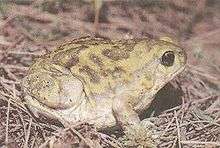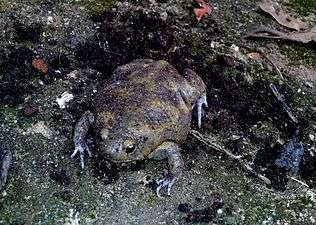Uperodon systoma
| Uperodon systoma | |
|---|---|
 | |
| Scientific classification | |
| Kingdom: | Animalia |
| Phylum: | Chordata |
| Class: | Amphibia |
| Order: | Anura |
| Family: | Microhylidae |
| Genus: | Uperodon |
| Species: | U. systoma |
| Binomial name | |
| Uperodon systoma (Schneider, 1799) | |
| Synonyms | |
|
Rana systoma Schneider, 1799 | |
Uperodon systoma is a species of narrow-mouthed frog found in Pakistan, India, Nepal, and Sri Lanka. It is known under many different common names: indistinct frog, marbled balloon frog, and lesser balloon frog.[2]
Description
As the common names suggest, Uperodon systoma have a very stout appearance with a relatively small head. They grow up to 64 mm (2.5 in) in snout–vent length.[3]
Uperodon systoma lack teeth. This unusual feature is probably related to their diet that (after metamorphosis) consists mainly of termites and ants, with other insects appearing in smaller numbers. It is suggested that in capturing such small but spatially clustered prey items teeth would not be very useful; instead, the prey are gathered using their tongue.[4]
Habitat and behaviour
Uperodon systoma is a fossorial species that buries itself in soil. These frogs have been observed in a number of habitats, such as dry forests, plains, gardens, and agricultural areas. Adults are only seen during the summer monsoons; otherwise they retreat into the soil.[1] Feeding may be concentrated to rainy nights during the monsoon when termites emerge to swarm.[5]
Breeding takes place during the monsoon rains when the males call from the banks of streams and paddy fields. Eggs are laid in water where they float.[1]
References
- 1 2 3 Das, I.; Dutta, S.; Manamendra-Arachchi, K.; de Silva, A. & Sharif Khan, M. (2009). "Uperodon systoma". IUCN Red List of Threatened Species. Version 2013.2. International Union for Conservation of Nature. Retrieved 16 January 2014.
- ↑ Frost, Darrel R. (2013). "Uperodon systoma (Schneider, 1799)". Amphibian Species of the World 5.6, an Online Reference. American Museum of Natural History. Retrieved 16 January 2014.
- ↑ Boulenger, G. A. (1890). Fauna of British India, including Ceylon and Burma. Reptilia and Batrachia. London: Taylor and Francis. p. 496.
- ↑ Das, I.; Coe, M. (1994). "Dental morphology and diet in anuran amphibians from south India". Journal of Zoology. 233 (3): 417–427. doi:10.1111/j.1469-7998.1994.tb05274.x.
- ↑ Das, I. (1996). "Resource use and foraging tactics in a south Indian amphibian community" (PDF). Journal of South Asian Natural History. 2 (1): 1–30.

